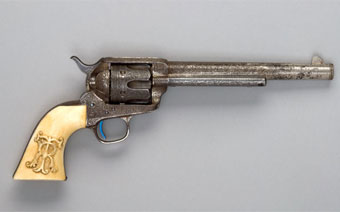 The Maxim machine gun (c. 1884) was quickly followed by others—the Hotchkiss, Lewis, Browning, Madsen, Mauser, and other guns.
The Maxim machine gun (c. 1884) was quickly followed by others—the Hotchkiss, Lewis, Browning, Madsen, Mauser, and other guns.
 Before the Gatling gun, there was the mitrailleuse or “grapeshot shooter”.
Before the Gatling gun, there was the mitrailleuse or “grapeshot shooter”.
Historians typically recognize Chinese fire lances, which were invented in the 10th century, as the first guns. It was invented by Samuel Colt (1814-1862) of Utah. And the arquebus — a long-barreled, musket-like weapon — was most likely the first personal firearm on mainland America. Hiram Stevens Maxim of the United States was the first inventor to incorporate this effect in a weapon design. They were muzzle loaded and fired by touching a burning wick to a touch hole in the back. The world's first sub-machine gun (a fully automatic firearm which fires pistol cartridges) able to be maneuvered by a single soldier is the MP18.1, invented by Theodor Bergmann. This particular firearm was the first gun that used mechanics to release a bullet. John Moses Browning was the prolific gun designer who invented the Winchester rifle (30/30), the pump shotgun, and the Colt 45 automatic. Morris S. Pynoos. These guns were rapid-firing, but they depended on the arm of the operator to crank out the bullets. Many early hand cannons were ignited with a " slow match " - a length of slender rope or cord that had been chemically treated so that an end could be ignited and would continue to burn or smolder, much like a 4 th of July punk used to shoot fireworks. In 1884, Hiram Maxim invented the first machine gun. It was called the Hand Gonne or hand cannon. He is best known for his automatic pistols and was the first one to invent the slide, which enclosed the barrel of a pistol and the firing mechanism. The Arabs, Mongrels, Chinese and the Europeans all claimed to have invented the first gun. Samuel Colt developed the first mass-produced, multi-shot, revolving firearms. There is no definitive inventor....for more info see: In the 10th century, the Chinese invented “Fire-spurting lances” which consisted of a bamboo rod or a metal rod to hold the gunpowder or the “huo yao”, which means fire-chemical. These bamboo or metal tubes projected flames and shrapnel at their targets. It was introduced into service in 1918 by the German Army during World War I as the primary weapon of the Stosstruppen (assault groups specialized in trench combat). Hiram Stevens Maxim of the United States was the first inventor to incorporate this effect in a weapon design. The man who invented the first machine gun was an English, named James Puckle. He was an American inventor and the first gun invented by him is known as the Gatling gun. Mitrailleuse – 1851. He invented the first foam ball and in 1969, the first Nerf Ball was introduced. The first Gatling guns were used in the American Civil War. The Maxim Machine Gun and Others . The first gun to combine all three components was the matchlock, in the early 1400's. This rapid-firing weapon was known as the Gatling gun. The First Gun. The first gun was most probably invented in China around 1250. Columbus and other early explorers were probably the first Europeans to bring guns to the New World, archaeologists say. The Maxim machine gun (c. 1884) was quickly followed by others—the Hotchkiss, Lewis, Browning, Madsen, Mauser, and other guns. The first mitrailleuse, developed by the Belgians in 1851, was a 50-barrel, rapid-fire weapon was capable of shooting up to 100 rounds a minute.A gun crew would load each barrel with a single rifle round. This technique carried over to firearms. The first machine gun called as Defense Gun was invented by James Puckle in 1718. Rifling* was invented [The first rifled gun barrels were made in the 1400s. This early date may be surprising, but makes perfect sense when one considers that arrow makers had learned to angle the fletchings on an arrow's shaft to make it spin as it flew through the air, giving it greater stability.
 The Maxim machine gun (c. 1884) was quickly followed by others—the Hotchkiss, Lewis, Browning, Madsen, Mauser, and other guns.
The Maxim machine gun (c. 1884) was quickly followed by others—the Hotchkiss, Lewis, Browning, Madsen, Mauser, and other guns. Before the Gatling gun, there was the mitrailleuse or “grapeshot shooter”.
Before the Gatling gun, there was the mitrailleuse or “grapeshot shooter”. The Maxim machine gun (c. 1884) was quickly followed by others—the Hotchkiss, Lewis, Browning, Madsen, Mauser, and other guns.
The Maxim machine gun (c. 1884) was quickly followed by others—the Hotchkiss, Lewis, Browning, Madsen, Mauser, and other guns. Before the Gatling gun, there was the mitrailleuse or “grapeshot shooter”.
Before the Gatling gun, there was the mitrailleuse or “grapeshot shooter”.